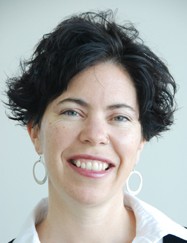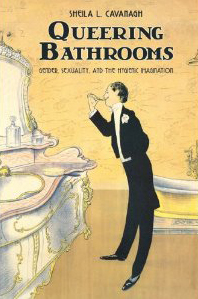 TORONTO, January 14, 2011 − Few people consider the public washrooms they use as bastions of segregation, but for York University sexuality studies Professor Sheila Cavanagh, these places are in fact among the last gender segregated public places in Western countries.
TORONTO, January 14, 2011 − Few people consider the public washrooms they use as bastions of segregation, but for York University sexuality studies Professor Sheila Cavanagh, these places are in fact among the last gender segregated public places in Western countries.
In her new book, Queering Bathrooms: Gender Sexuality and the Hygienic Imagination (University of Toronto Press, 2010), Cavanagh, a queer theorist, explores how the gendered nature of public washrooms has become a source of anxiety and political controversy in recent years.
“While talk about public facilities is often designated as out-of-bounds and not to mention crude and impolite in everyday conversation, these places condition ideas about gender and sexuality,” says Cavanagh. “Bathrooms have always been places where we segregate folks on the basis of gender, sexuality, class, disability and race.”
This segregation has a long history in North America, and Cavanagh says that in the not too distant past there were racially segregated bathrooms and water fountains in the American South. Today, people with physical disabilities are often desexualized by unisex facilities. “When you are physically disabled, your gender doesn’t seem to matter and you are desexualized in the built environment,” says Cavanagh.
She points out that separate bathrooms for the chamber maid or hired help were also built into many of the homes of the bourgeoisie classes. “In Toronto, bathrooms of today are often designated for ‘customers only’,” she says. “People who are homeless or street active or sex workers are frequently denied access to public facilities.”
 The book is based on 100 interviews Cavanagh conducted with lesbian, gay, bisexual, transgendered, queer and/or intersex (LGBTQI) people living in North American cities. It delves into the ways that queer and trans communities are challenging the rigid gendering and heteronormative composition of public washrooms. Incorporating theories from queer studies, trans studies, psychoanalysis and the work of French philosopher Michel Foucault, Cavanagh argues in the pages of Queering Bathrooms that the cultural politics of excretion are intimately related to the regulation of gender and sexuality.
The book is based on 100 interviews Cavanagh conducted with lesbian, gay, bisexual, transgendered, queer and/or intersex (LGBTQI) people living in North American cities. It delves into the ways that queer and trans communities are challenging the rigid gendering and heteronormative composition of public washrooms. Incorporating theories from queer studies, trans studies, psychoanalysis and the work of French philosopher Michel Foucault, Cavanagh argues in the pages of Queering Bathrooms that the cultural politics of excretion are intimately related to the regulation of gender and sexuality.
“I came up with the title Queering Bathrooms in discussions with my research assistants. We felt that it was important to prompt the reader to think about how the rules governing gender in the bathroom are queer – meaning odd or unusual,” says Cavanagh. “I refer to the hygienic imagination in the subtitle because part of what it means to govern the gender of bathroom users is to clean up or excommunicate those imagined to be ‘out of place’."
Many LGBTQI people she interviewed revealed they had witnessed or had been harassed for allegedly using the "wrong" washroom. It is no wonder, says Cavanagh, that activists must continue to campaign for more gender-neutral facilities.
"Access to bathrooms is a human rights issue and we must not police the gender of bathroom occupants," says Cavanagh. "While it is important to build gender neutral bathrooms, like the ones built at York University by the SexGen committee, it is equally important to challenge what counts as a man and as a woman when in more rigidly gendered rooms."
The cover image of Queering Bathrooms was chosen because the gender of the subject peering into the Victorian mirror is unclear, says Cavanagh. "The viewer wonders whether he/she is taking off a moustache or putting on lipstick. The slim hips and flat chest coupled with the wearing of a suit further complicates the image. I wanted a cover image that would prompt viewers to question our certainty about the gender identities of others in public spaces."
Her recommendation is not to do away with the gendered designs of bathrooms entirely, but to be uncertain about what the gendered signs mean. Creativity with gender signage would allow the bathroom to become a pedagogical space where patrons would be gently challenged about their assumptions about what counts as a man or as a woman.
In addition to the book, Cavanagh is now working on a script for a new play, Queer Bathroom Monologues. The first iteration of the play was staged at the book launch at the Gladstone Hotel, which took place in November.
York University is the leading interdisciplinary research and teaching university in Canada. York offers a modern, academic experience at the undergraduate and graduate level in Toronto, Canada’s most international city. The third largest university in the country, York is host to a dynamic academic community of 50,000 students and 7,000 faculty and staff, as well as 200,000 alumni worldwide. York’s 10 Faculties and 28 research centres conduct ambitious, groundbreaking research that is interdisciplinary, cutting across traditional academic boundaries. This distinctive and collaborative approach is preparing students for the future and bringing fresh insights and solutions to real-world challenges. York University is an autonomous, not-for-profit corporation.
Media Contact:
Janice Walls, Media Relations, York University, 416 736 2100 x22101, wallsj@yorku.ca

